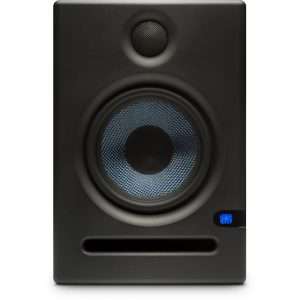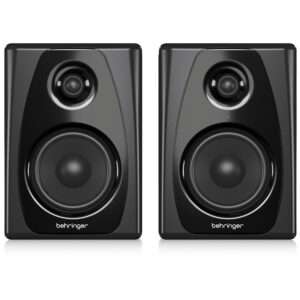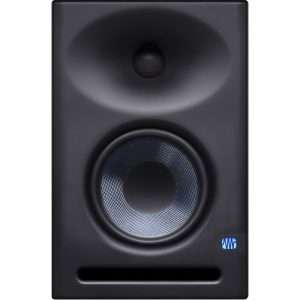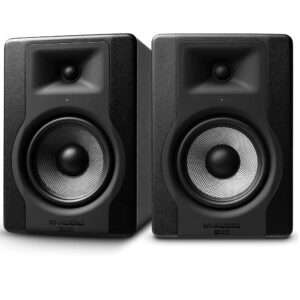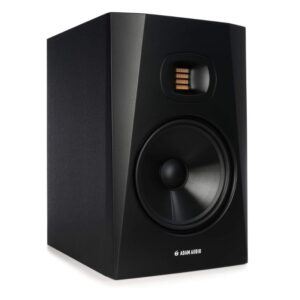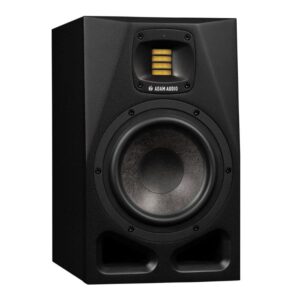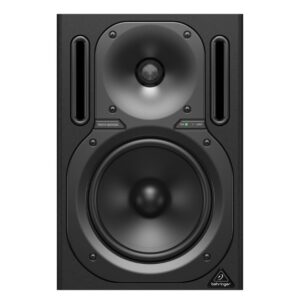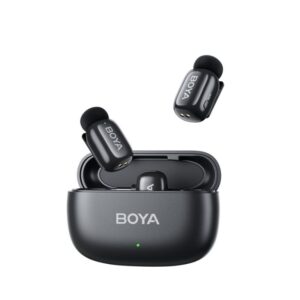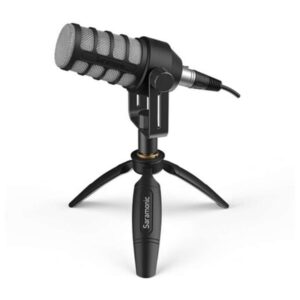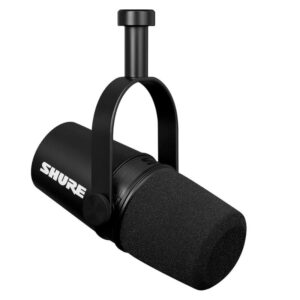Description
The ADAM Audio A44H is a prominent model in ADAM Audio’s A Series of active studio monitors, representing a blend of the company’s renowned tweeter technology with new woofer designs and advanced DSP (Digital Signal Processing) capabilities. It’s particularly notable for its horizontal orientation and dual-woofer configuration, making it versatile for both stereo and immersive audio setups.
Key Features and Highlights:
- Dual 4-inch Multi-Layer Mineral (MLM) Woofers: The A44H features two 4-inch long-throw woofers made from ADAM’s proprietary Multi-Layer Mineral material. This material is designed to be lightweight yet highly stable, ensuring high output with low distortion. The dual woofer setup provides significant punch and clarity, delivering a more robust low-end than a single 4-inch driver might.
- Rotatable X-ART (eXtended Accelerated Ribbon Technology) Tweeter with HPS Waveguide: This is a signature ADAM Audio feature. The X-ART tweeter is handmade in Germany and is known for its incredibly precise transient response, extended high-frequency range (up to 41 kHz at -3dB / 45 kHz at -6dB), and non-fatiguing sound. The tweeter is integrated into a rotatable HPS (High-frequency Propagation System) waveguide, made from a new glass fiber polymer compound. This allows you to rotate the tweeter in 90-degree steps, maintaining optimal dispersion whether you position the speaker horizontally (as designed) or vertically. This is crucial for maintaining a wide and consistent sweet spot.
- Hybrid Amplification (Class D for Woofers, Class AB for Tweeter): The A44H employs a hybrid amplification scheme:
- Class D amplifiers power the woofers, chosen for their efficiency and power, delivering linear performance with reduced distortion.
- Class AB amplifier powers the X-ART tweeter, providing a smooth, natural reproduction of high frequencies.
- Total Power: The system provides a total of 130W RMS (90W RMS for woofers, 15W RMS for tweeter).
- DSP-Based Electronics and Room Adaptation: This is a significant technological leap for the A Series.
- DSP Tuning: The monitors feature onboard DSP-based tuning capabilities, offering precise control over the monitor’s sound.
- Room Adaptation EQ: On the back panel, you’ll find four bands of room adaptation equalization: Bass, Desk, Presence, and Treble. Each band is adjustable in predefined steps, offering over 100 tuning options to help compensate for typical acoustic problems arising from speaker placement and room characteristics.
- Voicings (Pure & UNR): The A44H offers two selectable voicing profiles:
- “Pure”: A highly accurate and neutral sound, ideal for critical mixing and mastering.
- “UNR” (Uniform Natural Response): A more dynamic and musical response curve, reminiscent of older ADAM models like the A7X, which can be great for writing, composing, or casual listening.
- A Control Software (via Ethernet/RJ45): Deep integration with the ADAM A Control software (available for Windows and macOS) via an Ethernet port (RJ45). This allows for remote control of all DSP settings, including the voicings and detailed 6-band parametric EQ, offering even finer tuning than the rear-panel switches. Firmware updates can also be delivered via this connection.
- Sonarworks SoundID Reference Integration: The A44H (and other A Series models) has onboard processing that integrates with Sonarworks SoundID Reference (sold separately). This allows you to load your room correction profiles directly into the speakers, bypassing the need for a separate plugin in your DAW and ensuring consistent correction regardless of your audio source.
- Horizontal Form Factor (19-inch width): With a width of 19 inches, the A44H is designed to sit comfortably on a standard rack shelf or be mounted above or below a display. This low-profile design is particularly appealing for immersive audio setups (e.g., as a center channel in a Dolby Atmos system) or for those with limited vertical space.
- Dual Front-Ported Bass Reflex System: The A44H uses a dual front-firing bass port, which allows for more flexible placement closer to walls without the excessive bass buildup commonly associated with rear-ported designs.
- Versatile Audio Input Connectors:
- Balanced XLR Input: For professional connections.
- Unbalanced RCA Input: For consumer audio equipment.
- Mounting Options: Includes threaded inserts (M8) on the bottom for flexible mounting on stands or wall brackets.
- Max Peak SPL: Capable of a maximum peak SPL of 110dB (IEC-weighted noise) and 103dB SPL (sine-bursts) at 1 meter, providing good loudness for nearfield use.
- Frequency Response: Extended frequency response from 49 Hz to 41 kHz (-3dB) or 46 Hz to 45 kHz (-6dB).
Who is the ADAM Audio A44H for?
- Professional and Project Studio Engineers: Seeking highly accurate and transparent monitoring with the signature ADAM sound and advanced room correction capabilities.
- Immersive Audio Producers: The horizontal orientation and precise imaging make them excellent candidates for LCR (Left-Center-Right) channels in Dolby Atmos, Auro 3D, or other surround sound setups.
- Music Producers and Mixers: Who demand detailed highs, clear mids, and controlled bass for critical listening and mixing across various genres.
- Users with Space Constraints: The low-profile design is beneficial for setups where vertical space is limited.
- Those who value advanced calibration: The DSP and Sonarworks integration offer unparalleled control over the monitor’s sound in any room.
Considerations:
- Premium Price: ADAM Audio monitors are known for their high quality and come with a premium price tag compared to entry-level or even mid-range monitors.
- Requires Setup and Calibration: To fully utilize the DSP and room adaptation features, some setup and potentially an external measurement microphone (for Sonarworks) are required.
- Bass Extension (for 4-inch woofers): While the dual 4-inch woofers provide impressive bass for their size, for very low-end heavy genres or large rooms, a dedicated subwoofer (like the ADAM Audio Sub10 or Sub12) might be considered for truly accurate sub-bass translation.
- Horizontal Orientation: While a strength for specific setups, it might not be the preferred aesthetic or fit for all studio desk layouts.




















